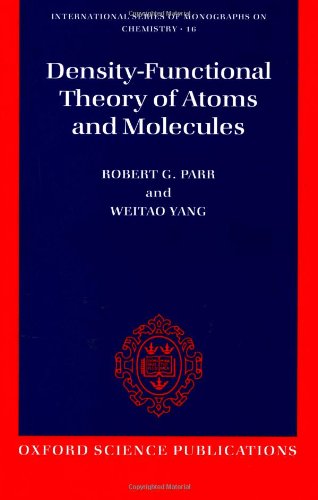Density functional theory of atoms and molecules book download
Par seay andrew le vendredi, août 12 2016, 05:43 - Lien permanent
Density functional theory of atoms and molecules. Robert G. Parr, Yang Weitao

Density.functional.theory.of.atoms.and.molecules.pdf
ISBN: 0195042794,9780195042795 | 338 pages | 9 Mb

Density functional theory of atoms and molecules Robert G. Parr, Yang Weitao
Publisher: Oxford University Press, USA
Density Functional Theory from past and recent developments to applications to large (bio)molecules: dedicated to John Pople, Walter Kohn, and John Perdew. O2 and NO2 can dissociate at the oxygen vacancy (VO) sites through filling the VO with one atomic O originated from the adsorbates. Collectively, I studied quantum mechanical aspects of scent to calculate the energy orbital, vibration, HOMO-LUMO gap, and bond lengths of aromatic molecules to find correlation between molecular vibration and scent using density functional theory. John Pople (1998 Nobel Prize in Chemistry). The research from the groups of Troganis and Melissas at the University of Ioannina is focused on simple dipeptides, and exploits molecular dynamic simulations, density functional theory based calculations and advanced nuclear magnetic resonance spectroscopy. Fifth, a DFT study on the potential application of a prototype ZnO (6,0) zigzag SWNT as gas sensor for H 2, O2, CO, NH3 and NO2 shows that the electron-donor molecules (CO and NH3) tend to enhance the concentration of major carriers ( electrons), whereas the electron-acceptor molecules (O 2 and NO2) tend to reduce the concentration. Of particular interest are metal complexes that involve gold atoms in the +1 valence state, due to their ability to self-assemble into 1)—an interpretation backed by DFT computations correlating the oscillation frequencies to gold–gold stretching vibrations. Cis-3-hexenol (C6H12O) and Cis-3-hexene-1-thiol (C6H12S) The only difference between two molecules is the oxygen and sulfur atom. Metal complexes are becoming increasingly important as the photochemical building blocks of functional molecular systems such as sensors and photoelectrochemical cells. To me, the most readily accessible data is the plots showing the probability of finding water oxygen and hydrogen atoms at a specific distance to selected groups in the peptide structure. This personal research is currently ongoing at UCI Furche lab on my spare time.